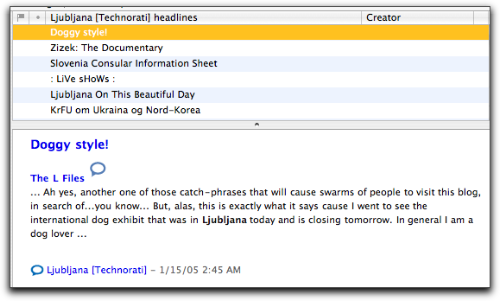I realize I’m talking to a small audience here, but just in case others in the Googlesphere encounter the same challenge, I’ll post a tip here.
I have a vector file of a logo in Freehand. I want to import the logo into Appleworks’ word processor in a format such that when I print the resulting document, the logo is printed at a high resolution.
The key here is to export from Freehand as a “Macintosh EPS” file. Then simply drag-and-drop the file into Appleworks, resize as required, and print.
The result is dramatically better than exporting from Freehand as a large bitmap file and importing and resizing in Appleworks (which results in a fuzzy and jagged logo).
Actual conversation snippet overheard in Beanz this morning:
Hey look, they have Greek Wraps here! Oh yah, I forgot, you don’t like Greece.
By the way, Beanz is a very different place on Sunday mornings, populated almost entirely by very stylish people. It’s almost like being in Halifax.
I written here before about Technorati. I’ve come to realize though, that outside of the narrow confines of technically-minded weblog people, the general web public might not be aware that Technorati can be a very powerful tool. Indeed I’ve only just discovered this myself recently.
So what is Technorati?
Perhaps the easiest way to understand it is as a sort of “Google for weblogs.”
Of course Google indexes weblogs, so you can use Google to search weblogs too. But Google also indexes porn, chemistry theses, and the weather in Istanbul. Technorati only indexes weblogs, and so its value as a search engine is that it allows you to limit your search only to “the blogosphere.”
Here’s an example of why this can be useful. Here’s a Google search for ljubljana hotel. Now, here’s a Technorati search for the same thing. The Google search returns “about 329,000” hits, the Technorati one returns 37.
On the surface, you might think this means Google is “better” because it returns more information. And certainly in those 300,000+ links are hundreds of hotel discounters, hotel website, travel websites, travel guides. But how about a personal opinion written by someone who has stayed in a hotel in Ljubljana? That’s where Technorati can be a useful supplementary search tool.
Technorati points to this post about staying in a Ljubljana hostel, this post about a family visit to the city and this post about a hotel operating without a permit.
Technorati isn’t a Google replacement, of course; it’s simply a way to drill through the web straight to personal writing. And sometimes that’s exactly the take you want on something.
With Technorati you can see what people are saying about your digital camera, read the blogosphere’s take on Jack Layton or find out what’s up in Charlottetown.
Where Technorati gets really interesting is that you can turn any Technorati search into a sort of “custom weblog” by creating something called a “Watchlist.” This is a feature of Technorati that’s not immediately obvious because it’s only available to members of Techorati. Membership is free, however, and available instantly (and, in my experience, does not result in any sort of spam flood).
Once you’re a member, every time you search Technorati you’ll see a “Make this a Watchlist” link. Click on the link, and Technorati gives you a URL that you can then feed to your favourite RSS newsreader; the feed contains a constantly-updated set of posts that watch your search.
Here’s a Watchlist for a search for ljubljana. And here’s how it looks in my newsreader:

Once you get your head around what’s happening here — a sort of arbitrary “blog of blogs” based on keywords — this is a really, really neat feature of Technorati.
Hendrik Hertzberg has a Talk of the Town piece in this week’s New Yorker (an issue that, by some miracle, actually arrived in Charlottetown during the week it was published!) about the reaction to the tsunami in which he writes, in part:
The terrible arbitrariness of the disaster has troubled clergymen of many persuasions. The Archbishop of Canterbury is among those newly struggling with the old question of how a just and loving God could permit, let alone will, such an undeserved horror. (Of course, there are also preachers, thankfully few, who hold that the horror is not only humanly deserved but divinely intended, on account of this or that sin or depredation.) The tsunami, like the city-size asteroid that, on September 29th, missed the earth by only four times the distance of the moon, is a reminder that, one way or another, this is the way the world ends. Man’s laws are proscriptive, nature’s merely descriptive.
Catherine and I have been considering a sort of “working vacation” in Ljubljana this spring. Somewhere in the back of my mind I thought “at least it’s far, far from the ocean.” Then this morning I read, in this blog from Ljubljana that:
Ljubljana has a serious history of earthquake’s hits. The first one took place back in 1511, and after that one Ljubljana needed to be partly rebuilt. Then, in 1895 a massive earthquake destroyed much of the city, razing most of it to the ground.
Like George Jones sings “There’s no place to run and hide, For He knows where you’re at, God’s gonna get ‘cha for that.” Or better more positively, we are safe nowhere, so we’re equally safe everywhere.
It’s only a year after we thought it would be, but it looks like Aliant is now supporting and selling the Treo 600 mobile phone. Price starts at $399 (requires a 3-year contract) and ranges up to $549 without a contract. Of course Palm has already released the Treo 650. It’s so darned hard to live on the edge of North America and the edge of technology at the same time…
Rogers prices for the Treo 600 start at $299 with a three-year contract and range up to $625 month to month, to Aliant’s pricing is competitive.
You think it’s Disney and Barney that are cleaning up in the North American baby media market? You’re wrong; it’s the bunny books:
.jpg)
That’s a photo that Ian posted this morning showing off new baby purchases. We own the same books. Indeed I think I’ve seen the same books in the house of every set of parents I’ve visited since Oliver was born.
By the way, let me take this opportunity to congratulate Mike the Stuffed Monkey on has new position at the top of Oliver’s stuffed animal collection. When Mike joined the family three years ago, Oliver was afraid of him. Which only makes sense because Mike was, at that time, actually bigger than Oliver. Today Oliver brought Mike to school to play a role in a workshopping of a stuffed “Goldilocks and the Three Bears.” Mike has arrived. He may not be a bear, but he’s arrived.
Almost every morning I walk through the Confederation Court Mall to Nature’s Harvest for a Red Berry Rush, and then out through the TD Bank on my way to the corner of Kent and Queen.
On the reception desk in the bank is a placard that gives an updated “customer service rating” for the bank. For the last while it has been reading “91.1%”
I wonder what that means. And whether it’s net positive or negative as a marketing effort. It’s possible to interpret this, without additional background, as “10 per cent of our customers are dissatisfied.” Which doesn’t seem like something you’d want to advertise.
A more effective, and actually useful approach to the same sort of thing was in the old Central Farmer’s Coop location on University Ave. The store has since been downgraded to a Coop Basics store, which has meant that most of the life has been sucked out of it; a decade ago, however, it still had some personality, and actually leant some credibility to the whole “You Are the Coop” slogan.
In any case, the old Coop had a suggestion box, and they actually read and posted their responses to all of the suggestions. Sometimes they could do something, sometimes they couldn’t, but they always responded. The suggestions ranged from things like “could you stay open longer hours?” to “how come you don’t have chocolate covered Oreos?”
What if, rather than giving us a hollow numeric representation, the TD Bank did likewise: add a suggestion/complaints box, and post each one, along with the response, on a bulletin board.
 I am
I am